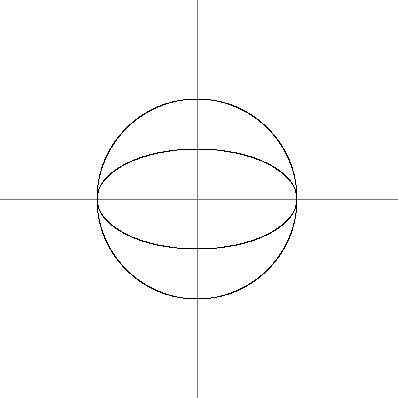|
|
This article refers to Bézout's theorem in algebraic geometry. For Bézout's theorem in arithmetic, go to Bézout's identity.
In mathematics, Bézout's theorem counts the number of intersections of two curves. It gives a number that is subject to 'interpretation'; but in any case is a maximum number of intersections that two algebraic curves can have, without having a common component curve.
In algebraic geometry, the statement of Bézout's theorem applies to the points of intersection of plane curves X of degree m and Y of degree n. It asserts that the number of intersections, counted by intersection multiplicity, is precisely mn, except in case X and Y have a common component. Therefore mn is the maximum finite number of intersection points. Here degree of a curve C means the degree of the polynomial defining it.
The special case where one of the curves is a line is a version of the fundamental theorem of algebra. For example, the parabola defined by y - x2 = 0 has degree 2; the line y - 2x = 0 has degree 1, and they meet in exactly two points.
From the case of lines, with m and n both 1, it is clear that one must work in the projective plane; to allow for higher degree cases one is forced to set the theorem in P2K over an algebraically closed field K.
Examples
Two distinct lines always meet in exactly one point. If they are parallel, that point lies at infinity. To see how this works algebraically, in projective space, the lines x+2y=3 and x+2y=5 are represented by the homogeneous equations x+2y-3z=0 and x+2y-5z=0. Solving, we get x= -2y and z=0, corresponding to the point (-2:1:0) in homogeneous coordinates. As the z-coordinate is 0, this point lies on the line at infinity.
Two circles never intersect in more than two points in the plane, while Bézout's theorem predicts four. The discrepancy comes from the fact that every circle passes through the same two complex points on the line at infinity. Writing the circle
- <math>(x-a)^2+(y-b)^2 = r^2<math>
in homogeneous coordinates, we get
- <math>(x-az)^2+(y-bz)^2 - r^2z^2 = 0,<math>
from which it is clear that the point (1:i:0) and (1:-i:0) lie on every circle. When two circles don't meet at all in the real plane plane (for example because they are concentric) they meet at these two points on the line at infinity and two other complex points which do not lie at infinity.
Any conic should meet the line at infinity at two points according to the theorem. A hyperbola meets it at two real points corresponding to the two directions of the asymptotes. An ellipse meets it at two complex points which are conjugate to one another---in the case of a circle, the points (1:i:0) and (1:-i:0). A parabola meets it at only one point, but it is a point of tangency and therefore counts twice.
In general, two conics meet in four points. The following pictures show examples in which the circle x2+y2-1=0 meets another ellipse in fewer intersection points because at least one of them has multiplicity greater than 1:
- <math>x^2+4y^2-1=0:\ \hbox{two intersections of multiplicity 2}<math>
- <math>5x^2+6xy+5y^2+6y-5=0:\ \hbox{an intersection of multiplicity 3}<math>
Missing image
Intersect4.png
Image:intersect4.png
- <math>4x^2+y^2+6x+2=0:\ \hbox{an intersection of multiplicity 4}<math>
The definition of intersection multiplicity is given at intersection number.


